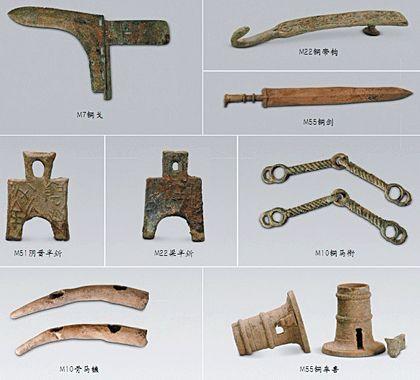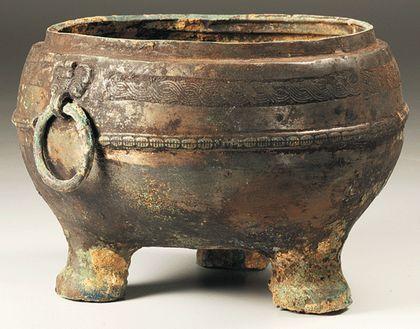The Cemetery of Rong People of the Warring States Period at Zhaitouhe in Huangling County, Shannxi Province
Chinese Institute of Archaeology
Source : http://www.kaogu.cn/en/detail.asp?ProductID=3290
In cooperation with an infrastructure project, Shannxi Provincial Institute of Archaeology conducted a detailed exploration and systematical excavations to the Warring States period cemetery located at Zhaitou Village, Adang Township in Huangling County, Shannxi province in April 2011. Presently a total of 90 tombs, 2 horse pits and a square pit containing a short bronze spear have been uncovered.
The cemetery is located near a tributary of Luo River. All tombs are shafts earth pit, mostly arranged in east-west direction. Besides, there are 13 tombs in south-north direction are arranged near the edge of the whole cemetery. Most tomb occupants are buried with heads toward east, and all occupants in tombs in south-north direction toward north. Their burial positions are mostly extended supine, also there are 6 flexed burials, 5 secondary burials and 1 dismembered burials. In most tombs wooden coffin traces could be seen. Some contain one single coffin and others one inner and one outer coffins. There are large, middle and small three different sized chambers, which probably indicate different social status. The two horse pits, which are located not very far away from the large sized tombs, are both in east-west direction, each containing two deliberate arranged side-by-side horses in a standard crouching position with head toward east. No chariot and horse gear remains has been found near these horses. A square pit with a large opening and a narrow bottom contains a spear measuring about 40 cm long, which probably serves for ritual use.

The excavations yield about one thousand miscellaneous burial objects made of ceramic, bronze, bone, iron, jade, shell, semi-precious stone beads and stone. Ceramics, including jars, Li vessels, basins, cups, Dou stemmed cups and Fu pots, are mainly living containers, except some roughly made smaller ones which could be models specially made for the burials. The bronze wares fall into three categories as body accessories like belt hookers, rings, bracelets, tubes and mirrors, weapons like Ge dagger-axes, swards and lances, horse and chariot fittings like bits, bells, animal-shaped ornaments etc. and ritual vessels like Ding tri-pots. Bone objects include horse gears, plaques and hairpin-like objects. Iron objects include belt hookers and rings. Strings of beads are made of jade, shell and semi-precious stone. Stone implements include mace-heads and whetstones. The burial objects differ distinctly with the size of the tombs. Small tombs bury only living potteries and bronze decorating objects. Middle-sized tombs contain weapons else like bronze swards and dagger-axes. While in large tombs, horse and chariot fittings, bronze Ding tri-pots and strings of jade and shell beads are very common. In additional, in middle sized tombs heads of cattle, sheep and horses are very commonly seen, which are often put on the top of coffins, or in niches of the tomb’s side walls.
Ceramics from the Zhaitouhe Cemetery could be assigned to Central Plains and Gansu-Qinghai two systems, which are often mixed with each other. Ceramics belonging to the Central Plain system are mainly jars and stem-cups, which are of strong characteristics of the period. According to coins buried together, the related tombs could be dated to the middle and late Warring States period. As to the Gansu-Qinghai system ceramics, they have many common characteristics with those from the Siwa Culture. Especially jars with a large mouth and Li vessels with bag-shaped feet bear noticeable resemblance in color, decoration and making technique with those from the Siwa Culture in eastern Gansu. While stemmed cups are very rare, and large-mouthed jars are different from that from the Siwa Culture jars which has a saddle shaped mouth, which could be result from different areas and periods. These features reveal that the cemetery probable is related to the Rong people in northwestern China.

In the Warring States period the south of Yan’an city where the Zhaitouhe Cemetery located was once a strategic land contested by Qin and Wei states over a long period. The Rong people remains in Zhaitouhe could be related to the two states. For example, the Li vessels with short feet are of apparent characteristics of the Wei State vessels. The bronze coins are import from the Wei State. The bronze Ding tri-pots, which bear rope and shell designs on the exterior belly, are very usual in the Three-Jin region during the Eastern Zhou period. The dagger-axes with a short and wide handle are also a common feature of the regional articles.
During the excavation, bronze, iron and semi-precious stone objects have been analyzed in laboratory. Human skeletons have been examined by anthropologists and paleopathologists, and animal bones are also analyzed. Many signs could relate the findings to the Rong people.
The discovery of the Zhaitouhe Cemetery fills a gap in the Western Rong archaeology in Shannxi Province. It is a hitherto known Rong people remain which developed farthest within the Central Plains, and also the first fully excavated cemetery from the Warring States period in Shannxi Province, which are of great significance for studying ethnic migrations and assimilations happened in late Warring States period in northern Shannxi. The cemetery being assigned to certain ethnic group and state will provide new materials for researches on pre-Qin politic territory and ethnic development. (Translator: Tong Tao)